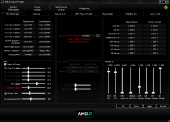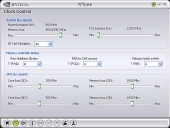The CPU
Some key terms to keep in mind when looking at the CPU are the multiplier (used to determine clock speed, and how fast the CPU performs internal operations) and the FSB (front side bus) which is how fast the CPU can communicate with other hardware on the motherboard. AMD replaced their FSB with Hyper-Transport Technology, of HTT.
One of the biggest issues with getting into overclocking is the steep learning curve, not in how to overclock, but in what to overclock. Generally speaking, if the CPU is the goal of the overclocking, the order would be:
- Multiplier
- FSB/HTT
- Voltage
- Rinse and repeat
The basics of this reasoning is that CPU speed = (Multiplier) x (FSB/HTT), so a multiplier of x9 with an FSB of 300MHz would be a CPU clock of 3.7 GHz, and as the multiplier is by far the lower number here, it has much more of an impact on clock speed. However, the multiplier (when it is unlocked) is also preferred because overclocking your FSB not only increases the speed at which your CPU is communicating, but also the RAM and video card. This means that overclocking the FSB can lead to instabilities with multiple parts. Voltage is used when instability is encountered, and should only be used when it is understood that increasing the voltage on a part by too much stands a very good chance of frying that part. I will go over voltage in a more in depth manner at a later point in this article.
Differentiating between processors
Keep in mind that many processors will have a “locked multiplier.” This means that the multiplier (x10 for example) can be decreased (x9, x8, etc.) but cannot be increased beyond stock. Both Intel and AMD sell “unlocked” processors, which allow the multiplier to be increased freely. These are differentiated differently by both companies: Intel uses a “k” at the end of the CPU’s name (i.e. the i7-2600k) while AMD brands their unlocked processors under the “Black” monicker (i.e. the Phenom II X6 1100T Black Edition).
It is very important to understand that the rated speed of the CPU is not the same as its actual speed. Intel CPU’s send four instructions per clock cycle, so an Intel CPU with a rated FSB of 800 MHz has an actual FSB of 200 MHz. AMD CPU’s on the other hand send two instructions per cycle, so an AMD CPU with a rated FSB of 600 MHz has an actual FSB of 300 MHz. When overclocking, you will only be dealing with the actual FSB speeds, so it is important to understand which manufacturer you are using and what your actual speeds will be. For this reason, AMD chips tend to overclock to higher FSB speeds, while Intel chips tend to get more performance from additional MHz.




[…] I-NAU320U Plus USB 3.0 HDD Docking Station and I-NC05 HDD Protection Box Review @ Hi Tech Legion How to Overclock Your Computer 101 @ TechwareLabs ADATA Classic Series CH11 1 TB USB 3.0 @ techPowerUp NZXT Sentry Mesh Fan Controller Review @ Hi […]
[…] tweetmeme_style = 'compact'; Author: ThinkComputers News Articles How to Overclock Your Computer 101 @ […]